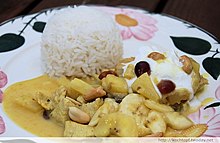
Riz Casimir (from French, sometimes Casimir Rice) is a curry dish originating in Switzerland. It is made from rice, sliced veal, curry sauce, and fruits, usually bananas, pineapples and peaches or cherries. It is also garnished with roasted almond slivers. Long-grain rice is normally used for Riz Casimir. Veal is often replaced with pork or chicken. Other fruits may also be used.
Riz Casimir was introduced by the Mövenpick company; it has been on the menu in the Mövenpick restaurants since 1952. Ueli Prager, the founder of Mövenpick, is generally credited for the creation of the dish. It was soon promoted in Swiss cookbooks, by Elisabeth Fülscher from 1960 and by Betty Bossi from 1968. According to historian Roger Sidler, this is a dish that reflects the increasing need for exoticism in post-war Switzerland. Casimir is perhaps derived from Kashmir, as cultural historian Petra Foede suggested, the dish being inspired by Indian cuisine.
Riz Casimir quickly became a popular dish in Switzerland, especially as a family dish. The Hero Cannery marketed canned fruits for Riz Casimir and the dish was also served in the army. Its popularity declined, however, by the end of the 20th century.
See also
References
- "Riz Casimir: Seit 1952 ein Hit" [Riz Casimir: A hit since 1952]. Betty Bossi. Retrieved 16 February 2023.
Obwohl Riz Casimir auf den ersten Blick ein exotisches Gericht zu sein scheint, ist es schweizerischen Ursprungs. Die kulinarische Erfindung der Gastrokette Mövenpick war gleich von Beginn weg ein Renner und steht seit 1952 zum Teil immer noch auf der Menükarte.
[Although Riz Casimir seems to be an exotic dish at first glance, it is of Swiss origin. The culinary invention of the Mövenpick gastro chain was a hit right from the start and some of it has still been on the menu since 1952.] - ^ Sidler, Roger (19 January 2020). "Riz Casimir – Niedergang eines Nationalgerichts" [Riz Casimir - Decline of a national dish]. Tages-Anzeiger. Retrieved 16 February 2023.
Mitten im Kalten Krieg war das anders: Kalbfleisch und Ananas aus der Büchse zeugten von Weltläufigkeit und Konsumlust, und sie fanden zusammen in einem Gericht, das eine Zeit lang so populär ist, dass man in der Deutschschweiz an ihm nicht vorbeikommt: dem Riz Casimir. Kein Sport- und Ferienlager, in dem am Abschlussabend den Jugendlichen nicht «Riis Kasimir» offeriert wird. Während der Kalte Krieg mit dem Einsturz der Berliner Mauer 1989 ein jähes und spektakuläres Ende findet, verschwindet Riz Casimir still und leise aus unseren Küchen. Der Fremdling, der uns einst von fernen Welten erzählte, funktioniert in der globalisierten Welt des neuen Jahrtausends nicht mehr. Wer im hintersten Winkel der Welt seine Ferien verbringt, kann der verschrobenen Exotik eines schweizerisch-pseudoindischen Gerichts nichts abgewinnen.
[Things were different in the middle of the Cold War: canned veal and pineapple testified to cosmopolitanism and consumerism, and they came together in a dish that was so popular for a while that you couldn’t avoid it in German-speaking Switzerland: Riz Casimir. There isn't a sports or holiday camp where the young people aren't offered "Riis Kasimir" on the final evening. While the Cold War came to an abrupt and spectacular end with the collapse of the Berlin Wall in 1989, Riz Casimir quietly disappeared from our kitchens. The stranger who once told us about distant worlds no longer works in the globalized world of the new millennium. Anyone who spends their holidays in the farthest corner of the world will not appreciate the quirky exoticism of a Swiss-pseudo-Indian dish.] - "Die Entstehungsgeschichte des Riz Casimirs" [The history of the origin of the Riz Casimir]. Ortsgeschichtliche Sammlung Seebach. Retrieved 16 February 2023.
Gemäss Petra Foede, einer deutschen Buchautorin, soll Ueli Prager schon in den späten 1940er Jahren in London ähnliche Gerichte kennen gelernt haben, welche in den dortigen Restaurants den Zusatz 'Kaschmir' trugen. Von einem dieser Gerichte habe er dann den Riz Casimir abgeleitet.
[According to Petra Foede, a German book author, Ueli Prager is said to have got to know similar dishes in London in the late 1940s, which carried the suffix 'Kashmir' in the restaurants there. He then derived the Riz Casimir from one of these dishes.] - "Schweizer Antwort gegen Foodwaste" [Swiss response against food waste]. Blick. 8 February 2023. Retrieved 16 February 2023.
Riz Casimir ist die kulinarische Hassliebe der Schweizer. Bekannt wurde das Gericht wegen Ueli Prager, dem Gründer der Restaurant- und Hotelkette Mövenpick, der in London «Kashmir dishes» entdeckte. Das Gericht passte er dem Schweizer Gaumen an und nahm es 1952 in die Speisekarten seiner Restaurants auf.
[Riz Casimir is the culinary love-hate relationship of the Swiss. The dish became known because of Ueli Prager, the founder of the restaurant and hotel chain Mövenpick, who discovered Kashmir dishes in London. He adapted the dish to the Swiss palate and added it to the menus of his restaurants in 1952.] - Fuchs, Regula (7 July 2022). "Schmelzkäse und Ananas haben ein Image-Problem" [Processed cheese and pineapple have an image issue]. Der Bund. Retrieved 17 February 2023.
Nun, da authentische fremdländische Nahrungsmittel in jedem Supermarkt erhältlich sind, munden Ersatz-Currys wie der Riz Casimir bloss noch einem Publikum, das sie in der Kindheit kennen gelernt hat und mit nostalgischen Gefühlen verbindet. Zudem ist die Aura der Exklusivität, den diese Fernweh-Gerichte einst mit sich brachten – in der Soziologie würde man von Distinktionsgewinn sprechen –, heute mit Produkten aus der Dose nicht mehr zu haben.
[Now that authentic foreign foods are readily available in any supermarket, substitute curries like Riz Casimir are only palatable to audiences who have seen them in childhood and are nostalgic for them. In addition, the aura of exclusivity that these wanderlust dishes once brought with them - in sociology one would speak of a gain in distinction - can no longer be had with products from a can.]